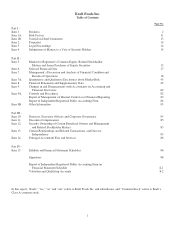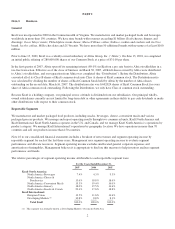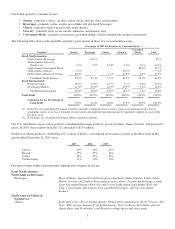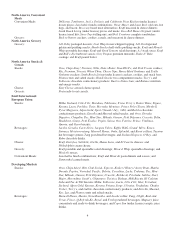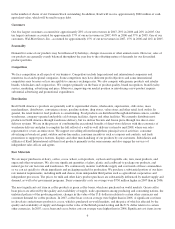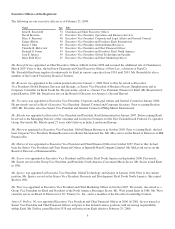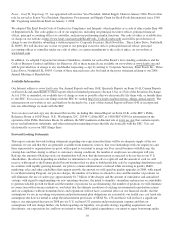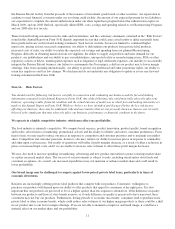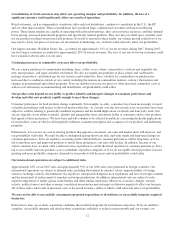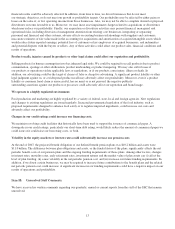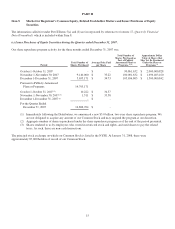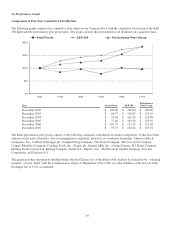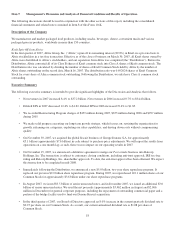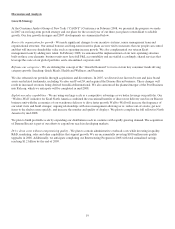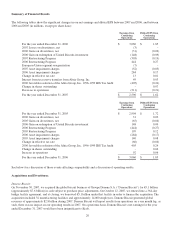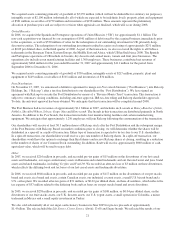Kraft 2007 Annual Report Download - page 26
Download and view the complete annual report
Please find page 26 of the 2007 Kraft annual report below. You can navigate through the pages in the report by either clicking on the pages listed below, or by using the keyword search tool below to find specific information within the annual report.the Danone Biscuit facility from the proceeds of the issuance of investment grade bonds or other securities; our expectation to
continue to meet financial covenants under our revolving credit facility; the amount of our expected payment for tax liabilities;
our expectation to complete the current authorization under our share repurchase program before the authorization expires in
March 2009; and our 2008 Outlook, specifically diluted EPS, costs, savings and spending related to our Restructuring Program;
and our 2008 effective tax rate.
These forward-looking statements involve risks and uncertainties, and the cautionary statements contained in the “Risk Factors”
found in this Annual Report on Form 10-K identify important factors that could cause actual results to differ materially from
those predicted in any such forward-looking statements. Such factors, include, but are not limited to, continued higher
input costs, pricing actions, increased competition, our ability to differentiate our products from private label products,
increased costs of sales, our ability to realize the expected cost savings and spending from our planned Restructuring
Program, difficulty in obtaining materials from our suppliers, the ability to supply our products and meet demand for our
products, our indebtedness and our ability to pay our indebtedness, unexpected safety or manufacturing issues, FDA or other
regulatory actions or delays, unanticipated expenses such as litigation or legal settlement expenses, our inability to successfully
integrate the Danone Biscuit business, our failure to consummate the Post merger, a shift in our product mix to lower margin
offerings, risks from operating internationally, our ability to protect our intellectual and other proprietary rights, our ability to
retain key employees and tax law changes. We disclaim and do not undertake any obligation to update or revise any forward-
looking statement in this Form 10-K.
Item 1A. Risk Factors.
You should read the following risk factors carefully in connection with evaluating our business and the forward-looking
information contained in this Annual Report on Form 10-K. Any of the following risks could materially adversely affect our
business, operating results, financial condition and the actual outcome of matters as to which forward-looking statements are
made in this Annual Report on Form 10-K. While we believe we have identified and discussed below the key risk factors
affecting our business, there may be additional risks and uncertainties that are not presently known or that are not currently
believed to be significant that may adversely affect our business, performance or financial condition in the future.
We operate in a highly competitive industry, which may affect our profitability.
The food industry is intensely competitive. We compete based on price, product innovation, product quality, brand recognition
and loyalty, effectiveness of marketing, promotional activity and the ability to identify and satisfy consumer preferences. From
time to time, we may need to reduce our prices in response to competitive and customer pressures and to maintain our market
share. Competition and customer pressures, however, also may restrict our ability to increase prices in response to commodity
and other input cost increases. Our results of operations will suffer if profit margins decrease, as a result of either a reduction in
prices or increased input costs, and if we are unable to increase sales volumes to offset those profit margin decreases.
We may also need to increase spending on marketing, advertising and new product innovation to protect existing market share
or capture increased market share. The success of our investments is subject to risks, including uncertainties about trade and
consumer acceptance. As a result, our increased expenditures may not maintain or enhance market share and could result in
lower profitability.
Our brand image may be challenged to compete against lower-priced private label items, particularly in times of
economic downturns.
Retailers are increasingly offering private label products that compete with our products. Consumers’ willingness to
purchase our products will depend upon our ability to offer products that appeal to consumers at the right price. It is also
important that our products are perceived to be of a higher quality than less expensive alternatives. If the difference in quality
between our products and those of store brands narrows, or if such difference in quality is perceived to have narrowed, then
consumers may not buy our products. Furthermore, during periods of economic uncertainty, consumers tend to purchase more
private label or other economy brands, which could reduce sales volumes of our higher margin products or there could be a shift
in our product mix to our lower margin offerings. If we are not able to maintain or improve our brand image, it could have a
material affect on our market share and our profitability.
11


